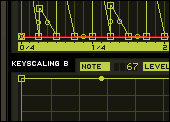


Italian version
.emusic

16.04.03 FM7, wave modulation software by Native Instruments.
Coming from Stanford University's Center Of Computer Research in Music and Acoustic, in the beat-generation California, inspired by the findings of a researcher at the Bell Laboratories, Max Mathews, and thanks to his support, John Chowing, a young graduate with some experience in music composing, in 1967, discovered that, by using two oscillators, was possible to obtain sounds very similar to those of some instruments (and many other things). FM synthesis is based on two sine waves. Their modulation produces a vibrato sound able to radically alter the harmonic nature of the modulated wave, therefore producing any type of sound. Kazukiyo Ishimura, another young engineer at Yamaha, one of the most important musical instruments makers in the world, immediately saw that discovery as something revolutionary. Yamaha quickly acquired a license to use that patent, continued its research on it, reproduced, synthesizing it, every musical note and, after seven years, began marketing the first keyboard FM synthesizer. The DX7 was born. Analog synthesizers already existed, of course, but a Moog 3 costed around $10,000, while Yamaha's synth costed a more affordable $2,000. Yamaha sold more than 200,000 pieces. For the first time, technological aids were affordable not only for the few rich producers and the big studios: an incredible number of musicians started to use electronic sounds, many new groups were born thanks to the DX7, as well as many new styles of music. To better understand the importance of that discovery, it must be told that the first computer sound cards were based on the same principle, the FM synthesis. More recently, with the increasing availability of powerful processors and low-cost RAM, synthesizers based on digital sampling, used mainly for their huge library of new sounds, would render FM synthesizers obsolete. Ad-hoc created samples are more adaptable to any kind of music. The software FM7 by Native Instruments, faithfully reproduces all the original sounds of the DX7 synth and its derivations (DX7-II, DX11, TX81Z, TX7, DX21, DX27, DX100, TX802), and succeeds in being a worthy successor of those historical synths, even surpassing their quality, thanks to the use of 32 different waveforms (instead of only one) and 128 new sound patches and additional presets, useful for those approaching this instrument for the first time. Its structure is not that of an emulator or a plug-in. On the contrary, its operations are exactly those of a synth based on frequency modulation algorithms. Even newbies will be able to immediately install the program and produce satisfying sounds in a matter of minutes. Even if heavily influenced by electronic music, new wave, synth-core and electronic pop, its use is not limited to these styles, therefore disproving the prejudice against FM synths, accused of being able to produce only 'empty' synthetical sounds. Even if so powerful, the program doesn't need many resources. With a recent CPU (a Mac G4 or a Pentium IV) it's quite possible to use it with no problems at all even with a sequencer, thanks to its support of both the VST and DXI standards. The visual editor is sophisticated, with its sound, pitch, LFO and modulation matrix controls. It also features a master page with global controls such as the output volume, where it's also possible to globally tweak the instrument (something which wasn't possible with the original), adding new effects. An 'easy' setting to quickly modify the main parameters starting from a preset facilitates its use, so even newbies and 'hackers' will be able to immediately experiment with it. With its both vintage and contemporary sounds, FM7 by Native Instrument is a complete tool, essential for every digital studio, able to bring FM synthesis up to date and to adapt it to more creative uses.
Aurelio Cianciotta